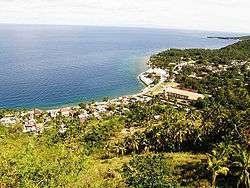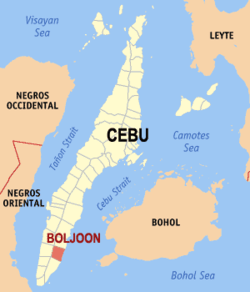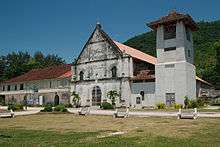Boljoon
| Boljoon | |
|---|---|
| Municipality | |
| Municipality of Boljoon | |
 Boljoon | |
 Map of Cebu with Boljoon highlighted | |
.svg.png) Boljoon Location within the Philippines | |
| Coordinates: 9°38′N 123°26′E / 9.63°N 123.43°ECoordinates: 9°38′N 123°26′E / 9.63°N 123.43°E | |
| Country |
|
| Region | Central Visayas (Region VII) |
| Province | Cebu |
| District | 2nd district of Cebu |
| Founded | 1600 |
| Barangays | 11 (see Barangays) |
| Government [1] | |
| • Type | Sangguniang Bayan |
| • Mayor | Merlou Derama |
| • Vice Mayor | Ervin Villanueva |
| • Congressman | Wilfredo Caminero |
| • Electorate | 10,216 voters (2016) |
| Area [2] | |
| • Total | 117.00 km2 (45.17 sq mi) |
| Elevation | 368 m (1,207 ft) |
| Population (2015 census)[3] | |
| • Total | 16,344 |
| • Density | 140/km2 (360/sq mi) |
| Time zone | UTC+8 (PST) |
| ZIP code | 6024 |
| PSGC | 072212000 |
| IDD : area code | +63 (0)32 |
| Climate type | Tropical climate |
| Income class | 5th municipal income class |
| Revenue (₱) | 64,105,986.59 (2016) |
| Native languages |
Cebuano Tagalog |
| Website |
www |
Boljoon, officially the Municipality of Boljoon, (Cebuano: Lungsod sa Boljoon; Tagalog: Bayan ng Boljoon), is a 5th class municipality in the province of Cebu, Philippines. According to the 2015 census, it has a population of 16,344 people.[3]
Boljo-on, as locally called on, has a total land area of 117.00 km2 (45.17 sq mi).
Boljoon is bordered to the north by the town of Alcoy, to the west are the towns of Malabuyoc, to the east is the Cebu Strait, and to the south is the town of Oslob.
The Boljoon Church is currently in the tentative list for UNESCO World Heritage Sites under the Baroque Churches of the Philippines (Extension). A proposal has been suggested by scholars to make a separate UNESCO inclusion for the Old Centre of Boljoon which includes the Boljoon Church. The same would be made for other churches listed in UNESCO's tentative sites, where each town plaza and surrounding heritage buildings would be added. No government agency has yet to take action on the proposal.
Barangays
Boljoon comprises 11 barangays, of which six (including Poblacion) are coastal, and the rest inland:
| PSGC | Barangay | Population | ±% p.a. | |||
|---|---|---|---|---|---|---|
| 2015[3] | 2010[4] | |||||
| 072212008 | Arbor | 6.6% | 1,076 | 1,035 | 0.74% | |
| 072212001 | Baclayan | 2.9% | 468 | 438 | 1.27% | |
| 072212002 | El Pardo | 20.0% | 3,264 | 2,953 | 1.92% | |
| 072212003 | Granada | 7.7% | 1,253 | 1,046 | 3.50% | |
| 072212004 | Lower Becerril | 7.9% | 1,297 | 1,153 | 2.27% | |
| 072212009 | Lunop | 5.6% | 916 | 874 | 0.90% | |
| 072212010 | Nangka | 4.2% | 679 | 590 | 2.71% | |
| 072212005 | Poblacion | 25.0% | 4,082 | 3,709 | 1.84% | |
| 072212006 | San Antonio | 6.8% | 1,114 | 1,125 | −0.19% | |
| 072212011 | South Granada | 5.1% | 839 | 813 | 0.60% | |
| 072212007 | Upper Becerril | 8.3% | 1,356 | 1,291 | 0.94% | |
| Total | 16,344 | 15,027 | 1.61% | |||
Demographics
| Population census of Boljoon | ||
|---|---|---|
| Year | Pop. | ±% p.a. |
| 1903 | 7,299 | — |
| 1918 | 9,121 | +1.50% |
| 1939 | 10,087 | +0.48% |
| 1948 | 11,299 | +1.27% |
| 1960 | 9,151 | −1.74% |
| 1970 | 11,049 | +1.90% |
| 1975 | 11,359 | +0.56% |
| 1980 | 10,735 | −1.12% |
| 1990 | 11,646 | +0.82% |
| 1995 | 12,318 | +1.06% |
| 2000 | 13,380 | +1.79% |
| 2007 | 14,877 | +1.47% |
| 2010 | 15,027 | +0.37% |
| 2015 | 16,344 | +1.61% |
| Source: Philippine Statistics Authority[3] [4] [5] [6] | ||
Boljoon Church

Nuestra Señora de Patrocinio Parish Church of Boljoon shows old and intricate carvings and bas-reliefs. It is in a pseudo-baroque rococo style. It has a main nave, a transcript, and twenty-eight pillars which support the walls. The walls are as thick as the pillars which are two metres (6 ft 7 in) thick and made of mortar and lime.
Boljoon became a visita of Carcar founded according to some authors in 1599. It became an independent vicariate on 31 October 1690, and on 5 April 1692, Fr. Nicolas de la Cuadra was appointed as prior. Because of the lack of priests, the church was turned over to the Jesuits on 27 September 1737, following the recommendation of the intermediate chapter of 1732. In the year 1747, the General of the Augustinians Order proposed the recovery of the parishes left off in the Visayas.[7]
Boljoon's earlier building had been destroyed in a raid in 1782, and its pastor Fr. Ambrosio Otero started rebuilding the following year. The work was continued by Fr. Manuel Cordero in 1794 but when Fr. Julian arrived, the work was not yet completed. He decided to build a blockhouse 120 by 80 metres (390 ft × 260 ft) on which artillery was mounted, and he enclosed the church perimeter with a wall. He finally completed the church. The church and the adjoining convento were restored by Fr. Leandro Moran (1920–1948) the last Augustinian friar to be assigned to Boljoon.[8]
In 1999 the National Historical Institute declared it a National Historical Landmark. The following year, the National Museum declared it as a National Cultural Treasure.
Nuestra Señora de Patrocinio Parish Church was lucky enough to withstand the 7.2 magnitude earthquake in 2013 which affected Bohol and Cebu.
Discovery of 16th-century artefacts
On February 2008, archaeologists discovered 26 human remains (with china plates on top of heads) and 16th-century artefacts beneath the parvis of Boljoon Church.[9]
References
- ↑ "Municipality". Quezon City, Philippines: Department of the Interior and Local Government. Retrieved 31 May 2013.
- ↑ "Province: Cebu". PSGC Interactive. Quezon City, Philippines: Philippine Statistics Authority. Retrieved 12 November 2016.
- 1 2 3 4 Census of Population (2015). "Region VII (Central Visayas)". Total Population by Province, City, Municipality and Barangay. PSA. Retrieved 20 June 2016.
- 1 2 Census of Population and Housing (2010). "Region VII (Central Visayas)". Total Population by Province, City, Municipality and Barangay. NSO. Retrieved 29 June 2016.
- ↑ Censuses of Population (1903–2007). "Region VII (Central Visayas)". Table 1. Population Enumerated in Various Censuses by Province/Highly Urbanized City: 1903 to 2007. NSO.
- ↑ "Province of Cebu". Municipality Population Data. Local Water Utilities Administration Research Division. Retrieved 17 December 2016.
- ↑ "Brief Historical Notes on Boljoon".
- ↑ "Boljoon Church".
- ↑ Philippine Sun Star 2008.
Sources
- Philippine Sun Star, Jujemay G. Awit (23 April 2008). "Remains, artifacts found in Boljoon". The Boljoon Blogs. Archived from the original on 29 September 2009.
| Wikimedia Commons has media related to Boljoon. |